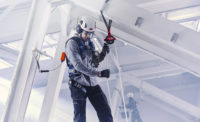Insufficient training or lack of expert advice can lead to disastrous consequences when it comes to fall arrest systems. One of the biggest examples of this is calculating fall distance, where a misjudgment isn't a simple error but a potentially life-threatening mistake.
A solid understanding of these systems and the ability to adapt them to various work conditions is crucial for safety. In this article, we'll guide you through the importance of accurately calculating fall distance and maintaining necessary clearance to avoid injuries.
OSHA’s stance on free fall distance
According to OSHA, “Freefall distance means the vertical displacement of the fall arrest attachment point on the employee's body belt or body harness between onset of the fall and just before the system begins to apply force to arrest the fall. This distance excludes deceleration distance, lifeline, and lanyard elongation but includes any deceleration device slide distance or self-retracting lifeline/lanyard extension before the devices operate and fall arrest forces occur.”
Limiting freefall distance is absolutely crucial for the safety of employees working at heights. By minimizing the free fall distance, the right system can slow the user's descent and bring the individual to a stop without contacting the ground below. But it's not just about preventing a collision with the ground; it's also about managing the forces experienced during the fall arrest to safeguard against the harmful impact during a jarring stop mid-air.
The less distance a worker falls before their fall arrest system engages, the less force they'll experience upon arrest, reducing the potential for a serious injury like broken bones or internal damage. The proper execution of this critical component of fall arrest can make the difference between a minor incident and a life-threatening event.
But limiting freefall distance isn't just a best practice, it's also an OSHA regulation:
“Personal fall arrest systems are rigged in such a manner that the employee cannot free fall more than 6 feet (1.8 m) or contact a lower level. A free fall may be more than 6 feet (1.8 m) provided the employer can demonstrate the manufacturer designed the system to allow a free fall of more than 6 feet and tested the system to ensure a maximum arresting force of 1,800 pounds (8 kN) is not exceeded.” 1910.140(d)(2)(ii)
Best practices to limit fall distance
At its most basic, a fall arrest system includes three main parts: a body harness, a fall-arrest device (this could be a lifeline, shock absorber, carabiner, connector, cable, etc.), and a system for anchorage. The free fall distance is how far you fall before the fall arrest system starts working, and the goal should be to make this distance as short as possible.
To do this, whenever possible, the worker should connect their lanyard to an anchorage point above their shoulders. This lowers the impact force, lessens the chance of hitting something, and decreases the severity of injuries while making emergency rescue easier. Anchorage points should also ideally be directly behind the worker because the risk of swinging during a fall increases with the horizontal distance between the worker’s harness and their anchorage point.
Important factors in fall arrest distance
Understanding and effectively managing freefall distances is critical in ensuring the safety of workers who operate at heights. Here are some key things to consider:
Length of the lanyard, harness, and anchorage connector: A worker who hasn't been trained might think a six-foot lanyard is enough when working at 10 or 12 feet. But, the lengths of the harness and anchorage connectors also need to be considered. For example, with a fixed anchor, you just add the distance to the ring. But when the anchor is part of a horizontal lifeline, the calculation gets more complicated. Horizontal lifelines are not pulled tight on purpose and can stretch during a fall. This stretching must be added to the calculation.
Deceleration distance: The deceleration device is often forgotten. When it's used, it adds another 3.5 feet to the lanyard length. The harness can also stretch, moving the anchorage point above the head during a fall. In this case, the distance isn't 6 feet, it's 10.5 feet.
Worker's height: Although it seems simple, this part is often left out when figuring out the fall arrest distance. It's really important to consider the worker's height below the anchorage point. A fall arrest system that stops a worker at 12 feet doesn't work if the ground is at 14 feet, unless the worker is less than 2 feet tall, which is very unlikely! On average, at least an extra 5 feet should be added into the calculation to account for the person's height.
By understanding the importance of limiting freefall distances, we can drastically reduce the likelihood of severe injuries or fatalities in the workplace. But it's not just about adhering to regulations set by OSHA, it's also about creating a safer working environment that prioritizes the well-being of employees.
Therefore, investing in proper training and expert advice is a non-negotiable aspect when dealing with fall arrest systems. Remember, a well-designed and properly utilized fall arrest system could mean the difference between life and death.
Given the increasing number of fatalities related to falls, it's crucial to prioritize fall safety to ensure everyone returns home safely each day. However, choosing the right protection for your company's specific fall risks can be challenging, especially when the consequences of a mistake are so high.



